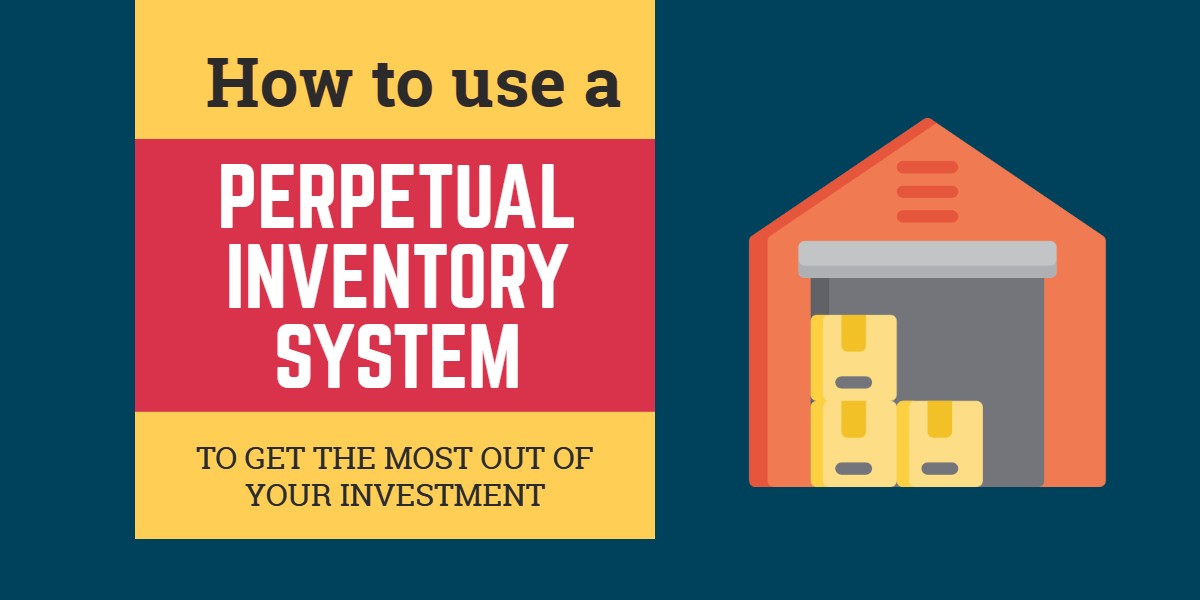What is a perpetual inventory system?
Companies using a perpetual inventory system track both the cost of goods sold and tools and equipment present in their itinerary. This practice is carried out to verify inventory balances in real-time. Doing this provides the accounting department with access to accurate inventory stock at all times. Generally, a perpetual inventory system revolves around the following:
- Received inventory goods
- Sold out inventory stock
- Items relocated within the warehouse
- Goods picked up from inventory for the production process
- Scrapped goods
In addition to listing down newly acquired items, the perpetual inventory system also keeps a record of checkout tools for various business tasks. In certain cases, the records might start to differ from actual inventory accounts due to undocumented transactions or theft. For this reason, it is critical to periodically compare book accounts with physical stock and that is where an automated inventory software comes into play.
Owing to computerized recordkeeping, perpetual inventory systems yield reliable results if used in compliance with a computer database comprised of stock quantities and bin locations. Employees find that a central database is much easier to update as it is accessible from anywhere and at any time. For instance, warehouse staff using barcode scanners to update stock movements can instantly update storage points. The same holds true for sale clerks at point-of-selling terminals. On the other hand, this inventory system loses its efficiency when used with inventory cards or manual tracking processes which tend to be time-consuming and prone to errors.
Advantages of a perpetual inventory system
Packed with a variety of intuitive features, perpetual inventory system provides the following benefits to its users:
- Accurate restocking: Instant updates on stock levels allow you to request for replenishment in advance. It also reduces the chances of stockouts and delays in daily business operations.
- Accounts for discrepancies: Unlike annual stock balances, perpetual inventory system lets you carry out inventory counts at regular intervals. This plays a vital role in detecting fraudulent activities. Real-time data lets you clear out these discrepancies before it’s too late.
- Precise financial statements: As stock values are constantly changing, an inventory management system which fails to update them regularly results in inaccurate profit and loss statements. In contrast to this, a perpetual inventory system provides you with real-time data regarding your stock changes so they are always included in your financial balances.
- Generate usage reports: For inventory intensive companies, it is critical to efficiently manage stock as inventory build-up ties up company resources. Using a perpetual inventory system, you can monitor trends in the usage patterns and alter procurement plans accordingly.
While this system can be a great value addition to your business, it still requires effort to ensure maintenance for inventory movement records. For this purpose, you need to deploy resources to track bin locations across all company sites and warehouses.
How to choose the right system for your processes

In order to figure out the right system for your business, it is important to classify the different types of inventory you own. Due to diverse project needs, companies usually invest their capital in the following avenues:
- Raw materials and supplies: Mostly acquired from external sources, firms stock spare parts from manufacturers and dealers. These are then used during production of goods or sold out to retailers.
- Finished goods: By using the raw materials in stock, companies produce finished goods for sale. Common examples include furniture, electronics, and cars.
- Maintenance, repair and operation inventories: Not a part of any final product, MRO inventory is consumed during the production of a good.
- Goods in transit: Mainly applicable to companies which export goods from external sources, goods in transit refer to inventory which stays on route for days. These require special monitoring to ensure safe arrival at destination sites.
- Buffer inventory: The market is an uncertain place which faces fluctuations on a daily basis. Known as safety stock, this refers to the excess inventory housed to cater to the unexpected increase in demand.
- Anticipatory stock: It is quite common for firms to hold goods for products they foresee a higher demand for in the near future. Mostly these comprise of raw materials and unfinished goods.
- Cycle Inventory: In order to make up for carrying and holding costs of inventory, companies order in bulks to save up. Doing this helps to optimize the procurement procedure.
After categorizing business inventory and laying down your objectives, it becomes easier to select the appropriate management program. If you are a small company operating with just a cash register, then you can make do with conventional systems. Firms featuring services instead of products don’t really require an inventory system either.
As your business expands and you acquire more capital goods, you need a structured mechanism to overlook daily tasks. It is quite challenging to monitor asset movement across locations without a central database. At this point, the ideal solution is to switch to a perpetual inventory system to have access to current and updated information at all times. Large and medium businesses usually require more robust inventory management systems as they deal with vast volumes of transactions and deploy automated financial management.
Features of a perpetual inventory system

Once you decide the management structure suited to your inventory, the next step is to understand how it works. The key lies in choosing the right software and getting the most out of it. Here are some features of a perpetual inventory system and guidelines on how to deploy them:
- RFID tracking for mass actions: In addition to choosing between barcodes and QR codes, an inventory software also lets you implement RFID tracking for specific tasks. This is mainly useful in scanning multiple items at once, as is the case in large shipments and off-site business projects. Record inventory check-in and checkouts effortlessly in your system in an efficient manner.
- GPS updates to upgrade warehouse management: Stock storage can be quite challenging if you don’t track goods coming in and going out. Employees waste a lot of time trying to find an item in an unorganized warehouse. For this purpose, an automated program allows you to instantly access and update locations for all your tools. Doing this expedites locating inventory and ensures traceability with instant location updates.
- Maintenance sessions to reduce downtime: Every equipment requires its own specialized maintenance routine so companies equipped with several different types of tools require implementing rigorous service events. A perpetual inventory system lets you check-in new assets for repair sessions. You can set up recurring services and define as many services as you like.
- Audits to eliminate stock discrepancies: Due to constant stock updates and movements across locations, it is critical to keep track of ownership. Your records should provide an accurate representation of your inventory at all times. In order to ensure this, an online system lets you carry out frequent audits to amend any errors that might occasionally arise. Doing this allows you to filter out your accounting balances as well.
- Document usage history to avoid excess inventory: Sometimes companies end up buying extra goods in wholesale to cut down on expenditure. If you are not adequately aware of market trends and future demand, a major portion of your stock will go to waste. Excess inventory is hard to dispose off and ties up capital which could have been used elsewhere. Seasonal fluctuations can have the same impact and render existing goods obsolete. To assess usage accurately, firms can track the history of inventory items to better measure demand and rightsize their inventory.
- Bundle products to optimize usage: Retail businesses understand the importance of bundling goods together to strike up sales. The same rule can be applied to any company regardless of its nature. In this way, you can package frequently used supplementary goods together to better organize inventory and also enhance employee experience. For instance, employees usually checkout a printer with a stack of papers to carry out a printing task. To save time, you can bundle these two together in your records.
- Depreciation reports for timely disposal: Perishable inventory is time sensitive and loses value over time. If goods expire before use, a systematic disposal mechanism needs to be in place. Applicable to all capital items, a perpetual inventory system lets you run depreciation reports at regular intervals. Doing this allows you to get rid of items before they cause disruptions in work operations.
- Customize data to increase accuracy: Data documentation is extremely essential when dealing with multiple assets deployed across locations. Every department has a set of requirements for purchasing tools. To make retrieval easier, an inventory system lets you add custom details to your data templates. Always have the right information at hand to facilitate accurate reporting.
Best practices and tips to streamline your inventory

The key to achieving a higher ROI on capital investments is to establish a set of best practices to follow. Contingent upon business goals and objectives, implementing a set of principles can boost performance as well as efficiency. Here are some tips to help you optimize the use of a perpetual inventory system:
Categorize your inventory
When it comes to business management, it is important to categorize capital investments according to value. There are items which get sold out more frequently than others whereas some have a higher rate of return. To ensure streamlined work operations, you can categorize your inventory as follows:
- Bestselling stock which requires constant reordering and quality reviews.
- Medium value goods which usually need reordering once a month.
- Low priority stock with minimal replenishment being carried in high volumes.
Optimize warehouse placement process
User-friendly access to the warehouse can speed up check-in and checkout procedures, even leading to an increase in customer orders. For this, you can organize storage by placing best selling items closest to the packing station. Additionally, a clutter-free packing station makes for efficient and accurate deliveries so be sure to return tools to the storage as soon as you are done working with them. Validate inventory counts by doing double rounds using a barcode or RFID tracking system.
Establish key metrics
The best way to boost business growth is to track a set of key performance indicators. This practice lets you build on your strengths and make amendments to your weak areas. For optimized inventory management, here are the metrics you should regularly track:
- Carrying costs
- Write off and write down
- Rate of turnover
- Cycle duration
- Procurement status and tracking
A perpetual inventory system lets you gather data on all of the above. Such information can be utilized to garner a structured efficiency program.
Determine a reorder point formula
Maintaining a balance between overstock and understock is perhaps one of the most crucial decisions for any company. The ideal way is to track usage to come up with a time frame for reordering. Some firms do this by setting a minimum inventory threshold so whenever this limit is reached, purchase orders are created for new stock. In-depth analysis of your utilization patterns can be used to arrive at this reorder point.
Reinvigorate turnover rates
Boosting sales is not the only way to increase earnings. It is also likely that some existing stock is pulling down revenue. Failing to account for changing demands can lead to businesses holding obsolete stock which ties up resources. To refine your finances, experimenting with pricing and liquidating old stock can be good strategies. A perpetual inventory system also lets you forecast customer demand to meet fluctuations in trends. Redistributing goods across the warehouse according to where they are more frequently needed can also revitalize your business performance.
Conclusion: Focused growth for optimal results
Selecting the right software is the first step toward business optimization. Focused growth involves setting up robust practices and learning to use the appropriate software. The key to success lies in the effective management of capital as well as human resources. Providing adequate training to employees and monitoring workflows is essential to achieving desired results. For this reason, all software programs let you supervise daily progress according to assigned tasks. By doing this, you can monitor which activities take extra time and what can be done to make them more productive. Choose a cloud-based system to help you achieve targets with supercharged features designed to cater to your inventory requirements.
About EZOfficeInventory
EZOfficeInventory is a perpetual inventory management software that helps production managers with asset allocation, maintenance, and reports. We’ve worked with scores of companies in the AV industry, and have helped them lower costs, optimize workflows, and improve transparency from one centralized location.








